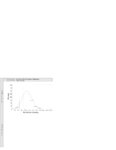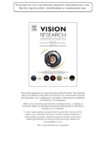|
|
Creator | Title | Description | Subject | Date |
| 151 |
 |
Digre, Kathleen B. | Serum vitamin A concentration is elevated in idiopathic intracranial hypertension. | OBJECTIVE: The primary purpose was to investigate whether serum vitamin A concentration is associated with idiopathic intracranial hypertension (IIH). The secondary aim was to obtain pilot data regarding the amount of vitamin A ingested by patients and controls. BACKGROUND: Vitamin A is an attractiv... | Vitamin A; Retinol; Idiopathic intracranial hypertension; Chromatography | 2007-02-01 |
| 152 |
 |
Normann, Richard A.; Kolb, Helga; Lasater, Eric M. | Signal integration at the pedicle of turtle cone photoreceptors: an anatomical and electrophysiological study | The morphology of the axon which connects the cell body and pedicle of turtle cone photoreceptors was studied by light and electron microscopy. The axon which contains numerous synaptic vesicles, some endoplasmic reticulum, and a few cisternae is basically filled with cytoplasm. The length of the ax... | Cone Photoreceptor, Voltage Clamp; Isolated Cells; Input Resistance; Cell Body-Pedicle Coupling | 1989 |
| 153 |
 |
Normann, Richard A. | Signal transmission from red cones to horizontal cells in the turtle retina | 1. Intracellular recordings were made from L-type horizontal cells in the retina of the turtle Pseudemys scripta elegans. The responses were evoked by 500 msec pulses of 'white' light. 2. L-type horizontal cells were classified as either, 'small receptive field' s.r.f. or 'large receptive field' l.r... | Turtles; Synapses; Retina; Photoreceptors | 1979 |
| 154 |
 |
Digre, Kathleen B. | Significance of CT and MR findings in sphenoid sinus disease. | Disorders of the paranasal sinuses, particularly the sphenoid sinus, can be associated with significant disorders of the optic and other cranial nerves. We examined 100 consecutive routine CT scans, 100 posterior fossa CT scans, and 100 MR scans to look for evidence of sinus disease, especially of t... | Sphenoid Sinus; Vision Disorders; Paranasal Sinus Diseases; Magnetic Resonance Imaging | 1989-05 |
| 155 |
 |
Normann, Richard A.; Abbasi, Masoud; Johansson,Torbjorn | Silicon carbide enhanced thermomigration | The widespread acceptance of thermomigration technology to produce through-chip interconnects has been impaired by (i) a random walk of the Si-Al liquid eutectic inclusion as it traverses the wafer, and (ii) a ?surface barrier? which allows thermomigration of only relatively large inclusions. In ... | Silicon Dioxide; Thermometers; Transducers; Thermomigration Technology; Infrared Lamps | 1992 |
| 156 |
 |
Normann, Richard A.; Campbell, Patrick K.; Jones, Kelly E.; Huber, Robert J.; Horch, Kenneth W. | Silicon-based, three-dimensional neural interface: manufacturing processes for an intracortical electrode array | A method has been developed for the manufacture of a "three-dimensional" electrode array geometry for chronic intracortical stimulation. This silicon based array consists of a 4.2 x 4.2 x 0.12 mm thick monocrystalline substrate, from which project 100 conductive, silicon needles sharpened to facilit... | Electric Stimulation; Electrodes, Implanted; Sensory Cortex; Intracortical Electrode Array | 1991 |
| 157 |
 |
Bernstein, Paul S. | Skin carotenoid status measured by resonance Raman spectroscopy as a biomarker of fruit and vegetable intake in preschool children | Background/Objective: Dietary assessment in children is difficult, suggesting a need to develop more objective biomarkers of intake. Resonance Raman spectroscopy (RRS) is a noninvasive, validated method of measuring carotenoid status in skin as a biomarker of fruit/vegetable intake. The purpose of t... | | 2012-01-01 |
| 158 |
 |
Levine, Edward M. | Sonic hedgehog promotes rod photoreceptor differentiation in mammalian retinal cells in vitro. | The hedgehog gene family encodes secreted proteins important in many developmental patterning events in both vertebrates and invertebrates. In the Drosophila eye disk, hedgehog controls the progression of photoreceptor differentiation in the morphogenetic furrow. To investigate whether hedgehog prot... | Sonic hedgehog; Indian hedgehog; Desert hedgehog; Retina; Mitogenesis; Differentiation; Rod Photoreceptor | 1997-08-15 |
| 159 |
 |
Zhang, Kang | Spectrum and frequency of FZD4 mutations in familial exudative vitreoretinopathy | Mutations in the frizzled-4 gene (FZD4) have recently been associated with autosomal dominant familial exudative vitreoretinopathy (FEVR) in families linking to the EVR1 locus on the long arm of chromosome 11. The purpose of this study was to screen FZD4 in a panel of 40 patients with FEVR to ident... | Frizzled-4 gene; FZD4; Mutation; autosomal dominant familial exudative autosomal dominant familial exudative; FEVR | 2004 |
| 160 |
 |
Normann, Richard A. | Statistical encoding model for a primary motor cortical brain-computer interface | A number of studies of the motor system suggest that the majority of primary motor cortical neurons represent simple movement-related kinematic and dynamic quantities in their time-varying activity patterns. An example of such an encoding relationship is the cosine tuning of firing rate with respect... | Discrete Distribution; LN Model; Neural Decoding; Neuroprosthetics; Sequential Monte-Carlo Filter | 2005 |
| 161 |
 |
Larson, Scott A. | Strabismus surgery complications: prevention and management | Strabismus surgery is increasingly becoming a subspecialty domain, especially with cyclovertical muscles, restricted muscles, or reoperations. While is impossible to completely eliminate complications from strabimus surgery, it is possible to minimize their occurrence and significance by proper prev... | Malignant hyperthermia; Overcorrection; Strabismus; Surgery; Undercorrection | 2003 |
| 162 |
 |
Normann, Richard A.; Shah, Maulik R. | Study of printed spiral coils for neuroprosthetic transcranial telemetry applications | We have explored the use of printed spiral coils (PSC's) for neuroprosthetic transcranial telemetry applications. We fabricated two-dimensional PSC's on a thin (25 microns) polyimide substrate using copper (35 microns) as a conducting material. All the coils had a fixed inner diameter of 1.0 cm. We ... | Blindness; Neuroprosthesis; Transcranial Telemetry System; Prosthesis Design | 1998 |
| 163 |
 |
Mamalis, Nick; Kleinmann, Guy; Chew, Jesse; Apple, David J. | Suturing a tear of the anterior capsulorhexis | AIM: To describe a new technique of suturing a tear in the anterior capsulorhexis. METHODS: Continuous curvilinear capsulorhexis (CCC) with lens removal was done in five fresh cadaver eyes. The diameter of the CCC was measured with a calliper. Using the same calliper a tear of the CCC was created wh... | Continuous curvilinear capsulorhexis; intraocular lens implantation; tear | 2006 |
| 164 |
 |
Normann, Richard A.; Muller, Jay F.; Kolb, Helga | Synaptic inputs to physiologically defined turtle retinal ganglion cells | Two physiologically distinct, HRP-marked turtle retinal ganglion cells were examined for their morphology, GABAergic, glycinergic, and bipolar cell synaptic inputs, using electron-microscopic autoradiography and postembedding immunocytochemistry. One cell was a color-opponent, transient ON/OFF gangl... | Turtles; Neural Pathways; Synapes; Retinal Ganglion Cells | 1991 |
| 165 |
 |
Swallow, Charles E.; Tsuruda, Jay S.; Digre, Kathleen B.; Glaser, Matthew J.; Davidson, H. Christian; Harnsberger, H. Ric | Terson syndrome: CT evaluation in 12 patients. | PURPOSE: Terson syndrome may be overlooked in the acute setting and often requires ophthalmologic intervention to prevent long-term visual loss. In this syndrome, vitreous or retinal hemorrhage results from an abrupt rise in intracranial pressure, leading to retinal venous hypertension and intraocul... | Retinal Hemorrhage; Visual Acuity; Vitreous Hemorrhage | 1998-04 |
| 166 |
 |
Normann, Richard A.; Johansson,Torbjorn; Abbasi, Masoud; Huber, Robert J. | Three-dimensional architecture for a parallel processing photosensing array | A three-dimensional architecture for a photosensing array has been developed. This silicon based architecture consists of a 10 x 10 array of photosensors with 80 microns diameter, through chip interconnects to the back side of a 500 microns thick silicon wafer. Each photosensor consists of a 300 x 3... | Retina; Optics; Silicon; Photosensing | 1992 |
| 167 |
 |
Olson, Randall J.; Spencer, Terrence S.; Mamalis, Nick | Three-year clinical comparison of 3-piece AcrySof and SI-40 silicone intraocular lenses | PURPOSE: To compare the 3-year performance of the 3-piece AcrySof (Alcon) and the SI-40 silicone (Allergan) intraocular lenses (IOLs). SETTING: John A. Moran Eye Center, University of Utah, Salt Lake City, Utah, USA. METHODS: In this retrospective study, patients with no complications and at least a... | Acrylic Resins; Silicone Elastomers; Prosthesis Design; Postoperative Complications; Patient Satisfaction; Cataract | 2002-07 |
| 168 |
 |
Baehr, Wolfgang | Tissue-specific expression in transgenic mice directed by the 5'-flanking sequences of the human gene encoding interphotoreceptor retinoid-binding protein | Interphotoreceptor retinoid-binding protein (IRBP) is an extracellular protein that has been suggested to participate in the visual process as a carrier for visual retinoids. A chimeric gene composed of the human IRBP promoter fused to the bacterial reporter gene chloramphenicol acetyltransferase (C... | Restriction Mapping; Nucleic Acid Hybridization; Mice; Gene Expression | 1990-05-25 |
| 169 |
 |
Crandall, Alan S. | Torn posterior capsule: prevention, recognition and management | Modern cataract surgery performed with phacoemulsification allows meticulous intraocular control and minimal incision size, but has the inherent risk of capsular rupture. Therefore, surgeons performing cataract surgery will inevitably face the complication of a torn posterior capsule. Torn posteri... | Capsulorrhexis complications; Phacoemulsification; Posterior capsular tears; Shallow anterior chamber; Suprachoroidal hemorrhage; Vitrectomy | 1999 |
| 170 |
 |
Bernstein, Paul S. | Transformations of selected carotenoids in plasma, liver, and ocular tissues of humans and in nonprimate animal models | PURPOSE: To determine the stereochemistry of carotenoids in human ocular tissues in comparison with plasma and liver and to elucidate the possible transformations of dietary (3R,3'R,6'R)-lutein and (3R,3'R)-zeaxanthin in the eye. Similarly, to characterize the carotenoid profiles in the eye tissues,... | Chromatography, High Pressure Liquid; Stereoisomerism; Xanthophylls | 2002 |
| 171 |
 |
Kriesel, John D.; Spruance, Spotswood L. | Treatment of herpes simplex labialis. | Recurrent herpes simplex labialis is associated with mild morbidity, but remains a significant problem for people with frequent and/or severe recurrences. Both topical and peroral episodic antiviral treatments of recurrences are modestly effective at reducing the duration of signs and symptoms. Rece... | Randomized Controlled Trials; Steroids; Drug Administration Routes | 2002 |
| 172 |
 |
Baehr, Wolfgang | Trilateral tumors in four different lines of transgenic mice expressing SV40 T-antigen | PURPOSE. A line of transgenic mice containing the simian virus (SV) 40 T-antigen (T-ag) gene driven by the beta-luteinizing hormone (BLH) promoter developed bilateral retinoblastoma and primitive neuroectodermal tumors (PNET) of the midbrain. Midbrain tumors arose from the subependymal layer of the ... | Mice, Transgenic; Retinol-Binding Proteins; Eye Proteins | 1996 |
| 173 |
 |
Frederick, Jeanne M. | Uncoordinated (UNC)119: Coordinating the trafficking of myristoylated proteins | The mechanism by which myristoylated proteins are targeted to specific subcellular membrane compartments is poorly understood. Two novel acyl-binding proteins, UNC119A and UNC119B, have been shown recently to function as chaperones/co-factors in the transport of myristoylated G protein a-subunits an... | | 2012-01-01 |
| 174 |
 |
Olson, Randall J. | Update on a long-term, prospective study of capsulotomy and retinal detachment rates after cataract surgery | PURPOSE: To evaluate the retinal detachment risks and neodymium:YAG (Nd:YAG) capsulotomy rates associated with different cataract approaches and intraocular lens (IOL) styles in a long-term,prospective clinical study. SETTING: Clinical practice of 1 ophthalmologist, Fort Collins, Colorado, USA. METH... | Cataract Extraction; Laser Therapy; Retinal Detachment; Risk Factors | 2000-07 |
| 175 |
 |
Crockett, David K. | Utility of gene-specific algorithms for predicting pathogenicity of uncertain gene variants | The rapid advance of gene sequencing technologies has produced an unprecedented rate of discovery for genome variation in humans. A growing numbered of authoritative clinical repositories archive gene variants and disease phenotype, yet there are currently many more gene variants that lack clear ann... | | 2012 |

























